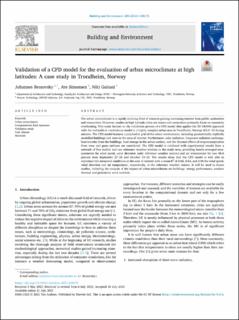| dc.contributor.author | Brozovsky, Johannes | |
| dc.contributor.author | Simonsen, Are Johan | |
| dc.contributor.author | Gaitani, Niki | |
| dc.date.accessioned | 2021-10-14T11:55:47Z | |
| dc.date.available | 2021-10-14T11:55:47Z | |
| dc.date.created | 2021-08-16T10:10:24Z | |
| dc.date.issued | 2021 | |
| dc.identifier.citation | Building and Environment. 2021, 205 . | en_US |
| dc.identifier.issn | 0360-1323 | |
| dc.identifier.uri | https://hdl.handle.net/11250/2823033 | |
| dc.description.abstract | The urban microclimate is a rapidly evolving field of research gaining increasing interest from public authorities and researchers. However, studies at high-latitude cities are scarce and researchers primarily focus on summerly overheating. This study focuses on the validation process of a CFD model that applies the 3D URANS approach with the realisable k-e turbulence model at a highly complex urban area in Trondheim, Norway (63.4° N) during autumn. The CFD model features a polyhedral grid of the urban environment, including geometrically explicitly modelled buildings and trees in the area of interest. Furthermore, solar radiation, longwave radiation exchange, heat transfer from the buildings, heat storage in the urban surface, and the thermal effects of evapotranspiration from trees and grass surfaces are considered. The CFD model is validated with experimental results from a network of five mobile and one reference weather stations in the study area, providing hourly-averaged measurements for wind speed, wind direction (only reference weather station) and air temperature for two 48-h periods from September 27–28 and October 19–20. The results show that the CFD model is well able to reproduce the measured conditions at the area of interest with a mean R2 of 0.60, 0.63, and 0.96 for wind speed, wind direction and air temperature, respectively, at the reference weather station. It will be used in future studies, including the analysis of the impact of urban microclimate on buildings’ energy performance, outdoor thermal and pedestrian wind comfort. | en_US |
| dc.language.iso | eng | en_US |
| dc.publisher | Elsevier | en_US |
| dc.relation.uri | https://www.sciencedirect.com/science/article/pii/S036013232100576X | |
| dc.rights | Navngivelse 4.0 Internasjonal | * |
| dc.rights.uri | http://creativecommons.org/licenses/by/4.0/deed.no | * |
| dc.title | Validation of a CFD model for the evaluation of urban microclimate at high latitudes: A case study in Trondheim, Norway | en_US |
| dc.type | Peer reviewed | en_US |
| dc.type | Journal article | en_US |
| dc.description.version | publishedVersion | en_US |
| dc.subject.nsi | VDP::Arkitektur og bygningsteknologi: 531 | en_US |
| dc.subject.nsi | VDP::Architecture and building technology: 531 | en_US |
| dc.source.pagenumber | 22 | en_US |
| dc.source.volume | 205 | en_US |
| dc.source.journal | Building and Environment | en_US |
| dc.identifier.doi | https://doi.org/10.1016/j.buildenv.2021.108175 | |
| dc.identifier.cristin | 1926197 | |
| dc.relation.project | Norges forskningsråd: 257660 | en_US |
| cristin.ispublished | true | |
| cristin.fulltext | original | |
| cristin.qualitycode | 2 | |

